MKT 645 - Marketing Research Proposal: EHR System, CIU, 2023
VerifiedAdded on 2023/04/20
|14
|2038
|251
Project
AI Summary
This marketing research proposal focuses on Electronic Health Records (EHR) and the challenges associated with their implementation and maintenance within the healthcare industry. It addresses the problem of balancing technological advancements with patient privacy and security concerns. The proposal outlines objectives to identify challenges in EHR implementation and develop mitigation strategies. Research questions target key stakeholders, including strategic managers, healthcare providers, CEOs, CIOs, and clinicians, to gather insights on data security, interoperability, value-based care, and clinical burnout. The research employs various techniques and considers existing data sources to develop a sampling strategy involving at least 50 participants. It details primary data collection and analysis methods, including textual analysis and coding. Furthermore, the proposal includes an estimated timeline, costs, and ethical considerations. The goal is to provide a holistic approach to improve EHR system implementation by addressing stakeholder concerns and promoting efficient healthcare delivery. Desklib provides access to similar documents and study tools to aid students in their academic pursuits.
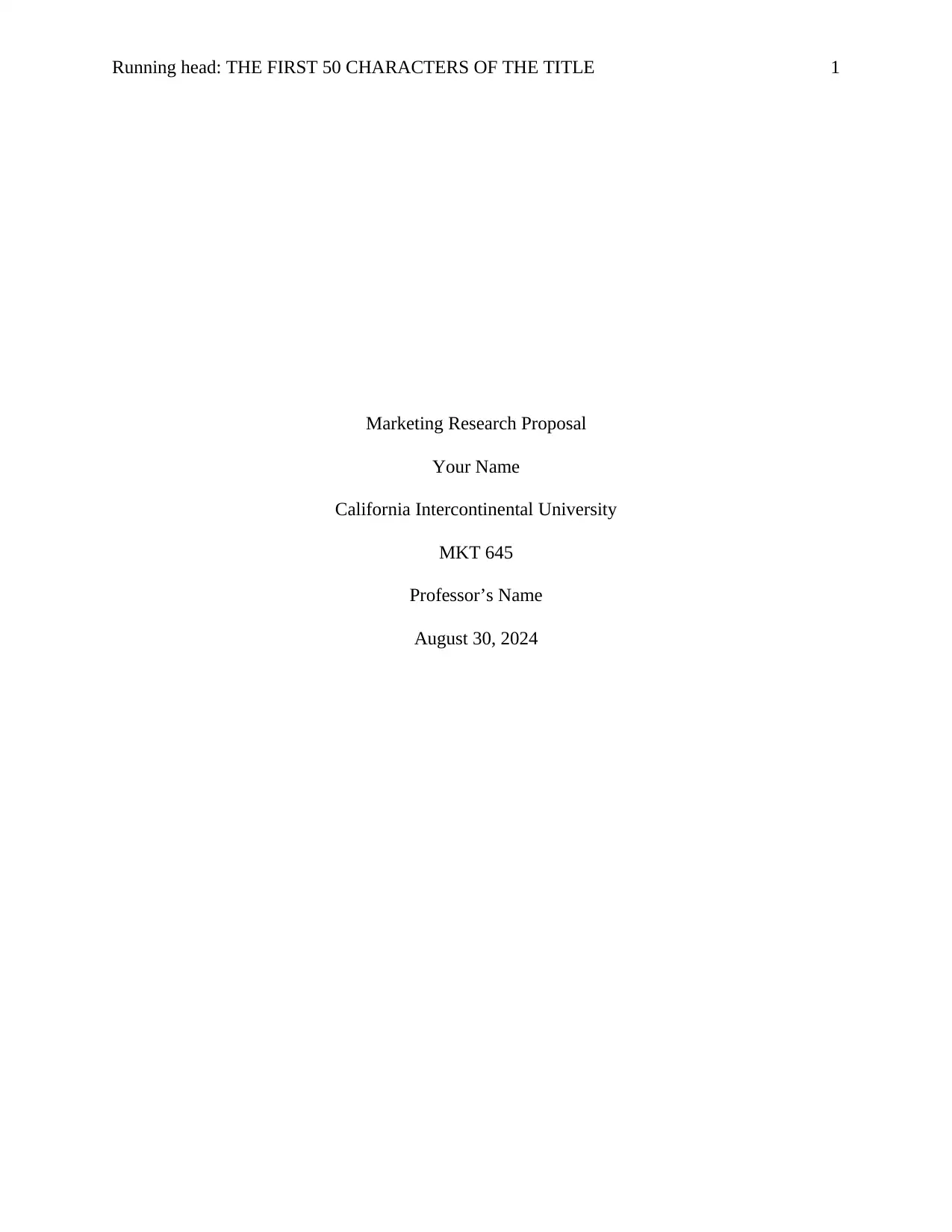
Running head: THE FIRST 50 CHARACTERS OF THE TITLE 1
Marketing Research Proposal
Your Name
California Intercontinental University
MKT 645
Professor’s Name
August 30, 2024
Marketing Research Proposal
Your Name
California Intercontinental University
MKT 645
Professor’s Name
August 30, 2024
Paraphrase This Document
Need a fresh take? Get an instant paraphrase of this document with our AI Paraphraser
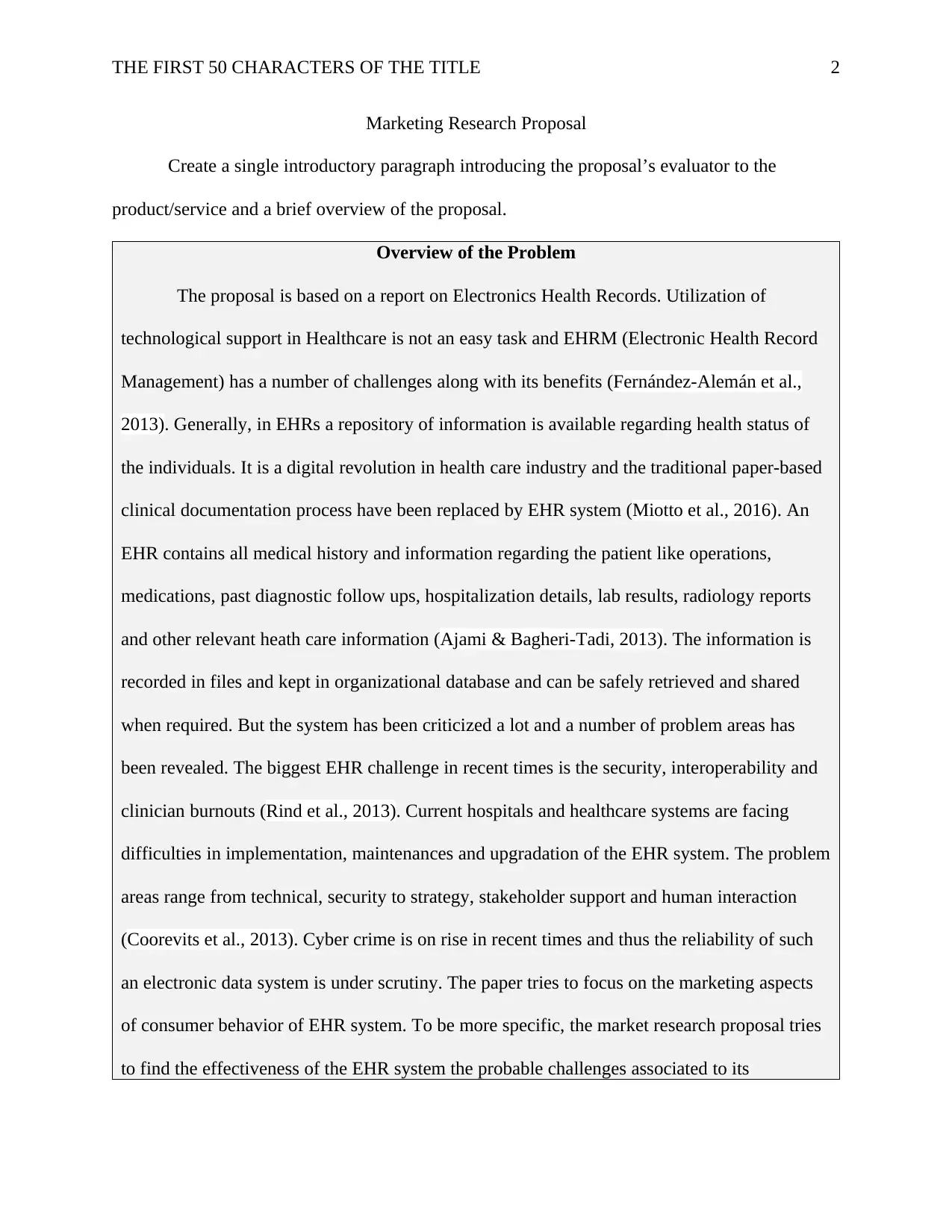
THE FIRST 50 CHARACTERS OF THE TITLE 2
Marketing Research Proposal
Create a single introductory paragraph introducing the proposal’s evaluator to the
product/service and a brief overview of the proposal.
Overview of the Problem
The proposal is based on a report on Electronics Health Records. Utilization of
technological support in Healthcare is not an easy task and EHRM (Electronic Health Record
Management) has a number of challenges along with its benefits (Fernández-Alemán et al.,
2013). Generally, in EHRs a repository of information is available regarding health status of
the individuals. It is a digital revolution in health care industry and the traditional paper-based
clinical documentation process have been replaced by EHR system (Miotto et al., 2016). An
EHR contains all medical history and information regarding the patient like operations,
medications, past diagnostic follow ups, hospitalization details, lab results, radiology reports
and other relevant heath care information (Ajami & Bagheri-Tadi, 2013). The information is
recorded in files and kept in organizational database and can be safely retrieved and shared
when required. But the system has been criticized a lot and a number of problem areas has
been revealed. The biggest EHR challenge in recent times is the security, interoperability and
clinician burnouts (Rind et al., 2013). Current hospitals and healthcare systems are facing
difficulties in implementation, maintenances and upgradation of the EHR system. The problem
areas range from technical, security to strategy, stakeholder support and human interaction
(Coorevits et al., 2013). Cyber crime is on rise in recent times and thus the reliability of such
an electronic data system is under scrutiny. The paper tries to focus on the marketing aspects
of consumer behavior of EHR system. To be more specific, the market research proposal tries
to find the effectiveness of the EHR system the probable challenges associated to its
Marketing Research Proposal
Create a single introductory paragraph introducing the proposal’s evaluator to the
product/service and a brief overview of the proposal.
Overview of the Problem
The proposal is based on a report on Electronics Health Records. Utilization of
technological support in Healthcare is not an easy task and EHRM (Electronic Health Record
Management) has a number of challenges along with its benefits (Fernández-Alemán et al.,
2013). Generally, in EHRs a repository of information is available regarding health status of
the individuals. It is a digital revolution in health care industry and the traditional paper-based
clinical documentation process have been replaced by EHR system (Miotto et al., 2016). An
EHR contains all medical history and information regarding the patient like operations,
medications, past diagnostic follow ups, hospitalization details, lab results, radiology reports
and other relevant heath care information (Ajami & Bagheri-Tadi, 2013). The information is
recorded in files and kept in organizational database and can be safely retrieved and shared
when required. But the system has been criticized a lot and a number of problem areas has
been revealed. The biggest EHR challenge in recent times is the security, interoperability and
clinician burnouts (Rind et al., 2013). Current hospitals and healthcare systems are facing
difficulties in implementation, maintenances and upgradation of the EHR system. The problem
areas range from technical, security to strategy, stakeholder support and human interaction
(Coorevits et al., 2013). Cyber crime is on rise in recent times and thus the reliability of such
an electronic data system is under scrutiny. The paper tries to focus on the marketing aspects
of consumer behavior of EHR system. To be more specific, the market research proposal tries
to find the effectiveness of the EHR system the probable challenges associated to its
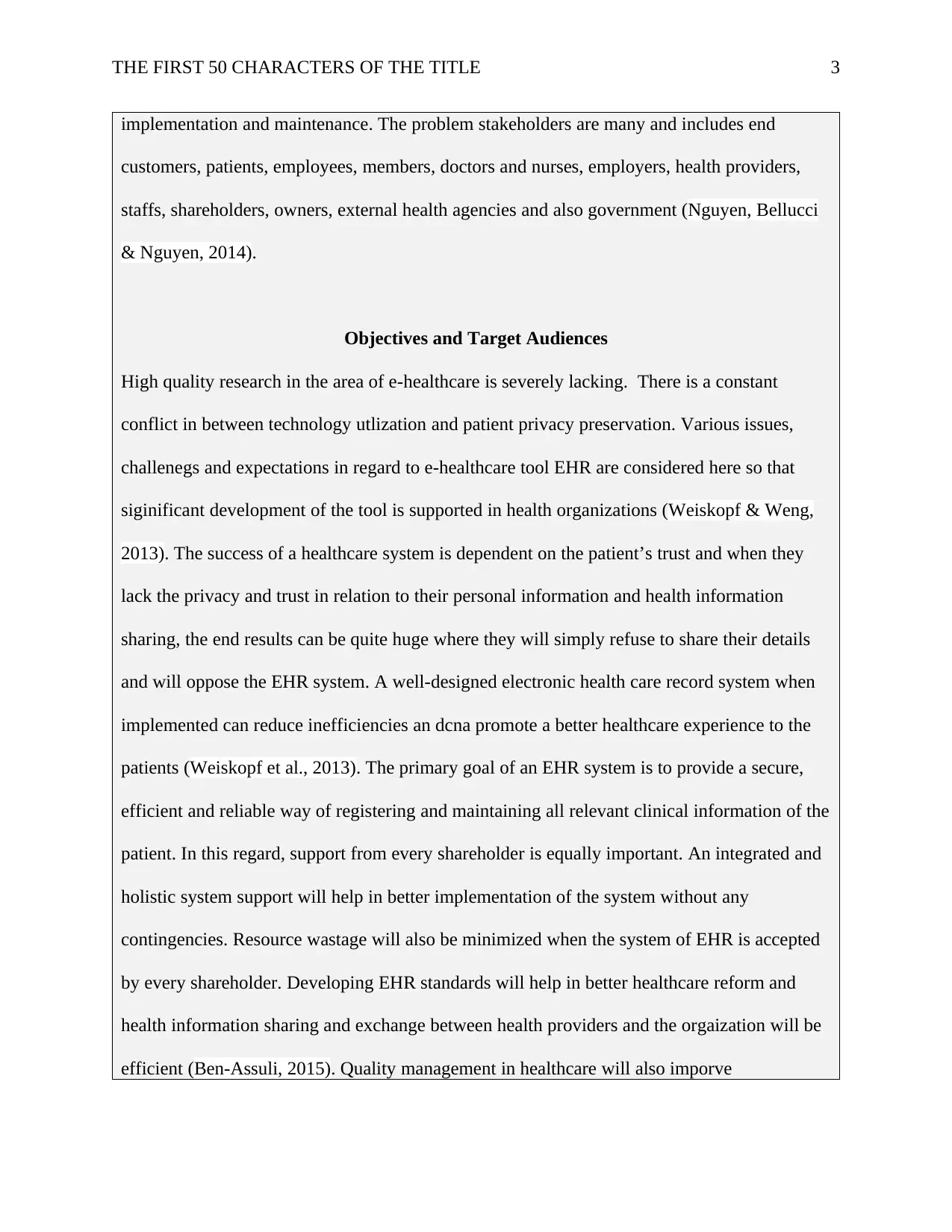
THE FIRST 50 CHARACTERS OF THE TITLE 3
implementation and maintenance. The problem stakeholders are many and includes end
customers, patients, employees, members, doctors and nurses, employers, health providers,
staffs, shareholders, owners, external health agencies and also government (Nguyen, Bellucci
& Nguyen, 2014).
Objectives and Target Audiences
High quality research in the area of e-healthcare is severely lacking. There is a constant
conflict in between technology utlization and patient privacy preservation. Various issues,
challenegs and expectations in regard to e-healthcare tool EHR are considered here so that
siginificant development of the tool is supported in health organizations (Weiskopf & Weng,
2013). The success of a healthcare system is dependent on the patient’s trust and when they
lack the privacy and trust in relation to their personal information and health information
sharing, the end results can be quite huge where they will simply refuse to share their details
and will oppose the EHR system. A well-designed electronic health care record system when
implemented can reduce inefficiencies an dcna promote a better healthcare experience to the
patients (Weiskopf et al., 2013). The primary goal of an EHR system is to provide a secure,
efficient and reliable way of registering and maintaining all relevant clinical information of the
patient. In this regard, support from every shareholder is equally important. An integrated and
holistic system support will help in better implementation of the system without any
contingencies. Resource wastage will also be minimized when the system of EHR is accepted
by every shareholder. Developing EHR standards will help in better healthcare reform and
health information sharing and exchange between health providers and the orgaization will be
efficient (Ben-Assuli, 2015). Quality management in healthcare will also imporve
implementation and maintenance. The problem stakeholders are many and includes end
customers, patients, employees, members, doctors and nurses, employers, health providers,
staffs, shareholders, owners, external health agencies and also government (Nguyen, Bellucci
& Nguyen, 2014).
Objectives and Target Audiences
High quality research in the area of e-healthcare is severely lacking. There is a constant
conflict in between technology utlization and patient privacy preservation. Various issues,
challenegs and expectations in regard to e-healthcare tool EHR are considered here so that
siginificant development of the tool is supported in health organizations (Weiskopf & Weng,
2013). The success of a healthcare system is dependent on the patient’s trust and when they
lack the privacy and trust in relation to their personal information and health information
sharing, the end results can be quite huge where they will simply refuse to share their details
and will oppose the EHR system. A well-designed electronic health care record system when
implemented can reduce inefficiencies an dcna promote a better healthcare experience to the
patients (Weiskopf et al., 2013). The primary goal of an EHR system is to provide a secure,
efficient and reliable way of registering and maintaining all relevant clinical information of the
patient. In this regard, support from every shareholder is equally important. An integrated and
holistic system support will help in better implementation of the system without any
contingencies. Resource wastage will also be minimized when the system of EHR is accepted
by every shareholder. Developing EHR standards will help in better healthcare reform and
health information sharing and exchange between health providers and the orgaization will be
efficient (Ben-Assuli, 2015). Quality management in healthcare will also imporve
⊘ This is a preview!⊘
Do you want full access?
Subscribe today to unlock all pages.

Trusted by 1+ million students worldwide
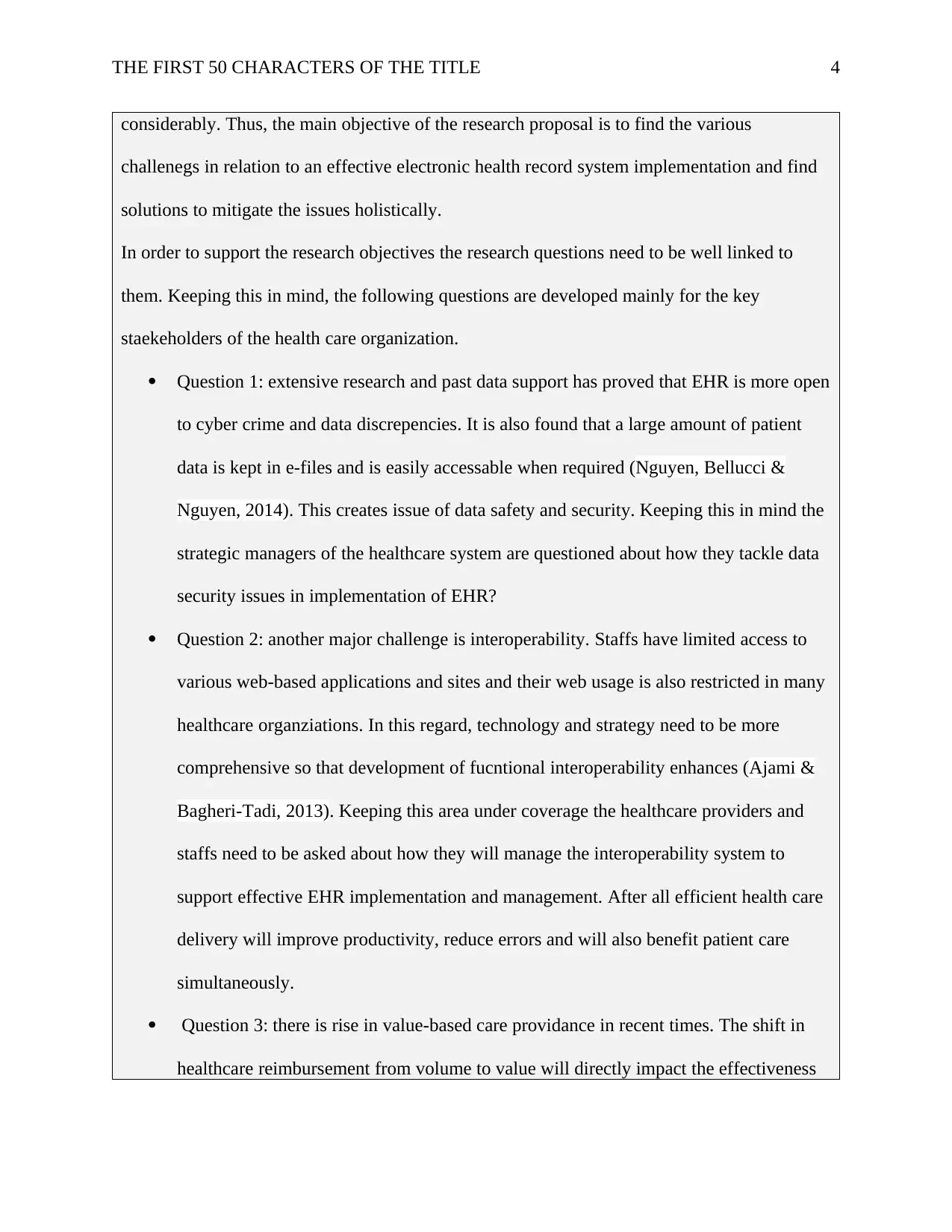
THE FIRST 50 CHARACTERS OF THE TITLE 4
considerably. Thus, the main objective of the research proposal is to find the various
challenegs in relation to an effective electronic health record system implementation and find
solutions to mitigate the issues holistically.
In order to support the research objectives the research questions need to be well linked to
them. Keeping this in mind, the following questions are developed mainly for the key
staekeholders of the health care organization.
Question 1: extensive research and past data support has proved that EHR is more open
to cyber crime and data discrepencies. It is also found that a large amount of patient
data is kept in e-files and is easily accessable when required (Nguyen, Bellucci &
Nguyen, 2014). This creates issue of data safety and security. Keeping this in mind the
strategic managers of the healthcare system are questioned about how they tackle data
security issues in implementation of EHR?
Question 2: another major challenge is interoperability. Staffs have limited access to
various web-based applications and sites and their web usage is also restricted in many
healthcare organziations. In this regard, technology and strategy need to be more
comprehensive so that development of fucntional interoperability enhances (Ajami &
Bagheri-Tadi, 2013). Keeping this area under coverage the healthcare providers and
staffs need to be asked about how they will manage the interoperability system to
support effective EHR implementation and management. After all efficient health care
delivery will improve productivity, reduce errors and will also benefit patient care
simultaneously.
Question 3: there is rise in value-based care providance in recent times. The shift in
healthcare reimbursement from volume to value will directly impact the effectiveness
considerably. Thus, the main objective of the research proposal is to find the various
challenegs in relation to an effective electronic health record system implementation and find
solutions to mitigate the issues holistically.
In order to support the research objectives the research questions need to be well linked to
them. Keeping this in mind, the following questions are developed mainly for the key
staekeholders of the health care organization.
Question 1: extensive research and past data support has proved that EHR is more open
to cyber crime and data discrepencies. It is also found that a large amount of patient
data is kept in e-files and is easily accessable when required (Nguyen, Bellucci &
Nguyen, 2014). This creates issue of data safety and security. Keeping this in mind the
strategic managers of the healthcare system are questioned about how they tackle data
security issues in implementation of EHR?
Question 2: another major challenge is interoperability. Staffs have limited access to
various web-based applications and sites and their web usage is also restricted in many
healthcare organziations. In this regard, technology and strategy need to be more
comprehensive so that development of fucntional interoperability enhances (Ajami &
Bagheri-Tadi, 2013). Keeping this area under coverage the healthcare providers and
staffs need to be asked about how they will manage the interoperability system to
support effective EHR implementation and management. After all efficient health care
delivery will improve productivity, reduce errors and will also benefit patient care
simultaneously.
Question 3: there is rise in value-based care providance in recent times. The shift in
healthcare reimbursement from volume to value will directly impact the effectiveness
Paraphrase This Document
Need a fresh take? Get an instant paraphrase of this document with our AI Paraphraser
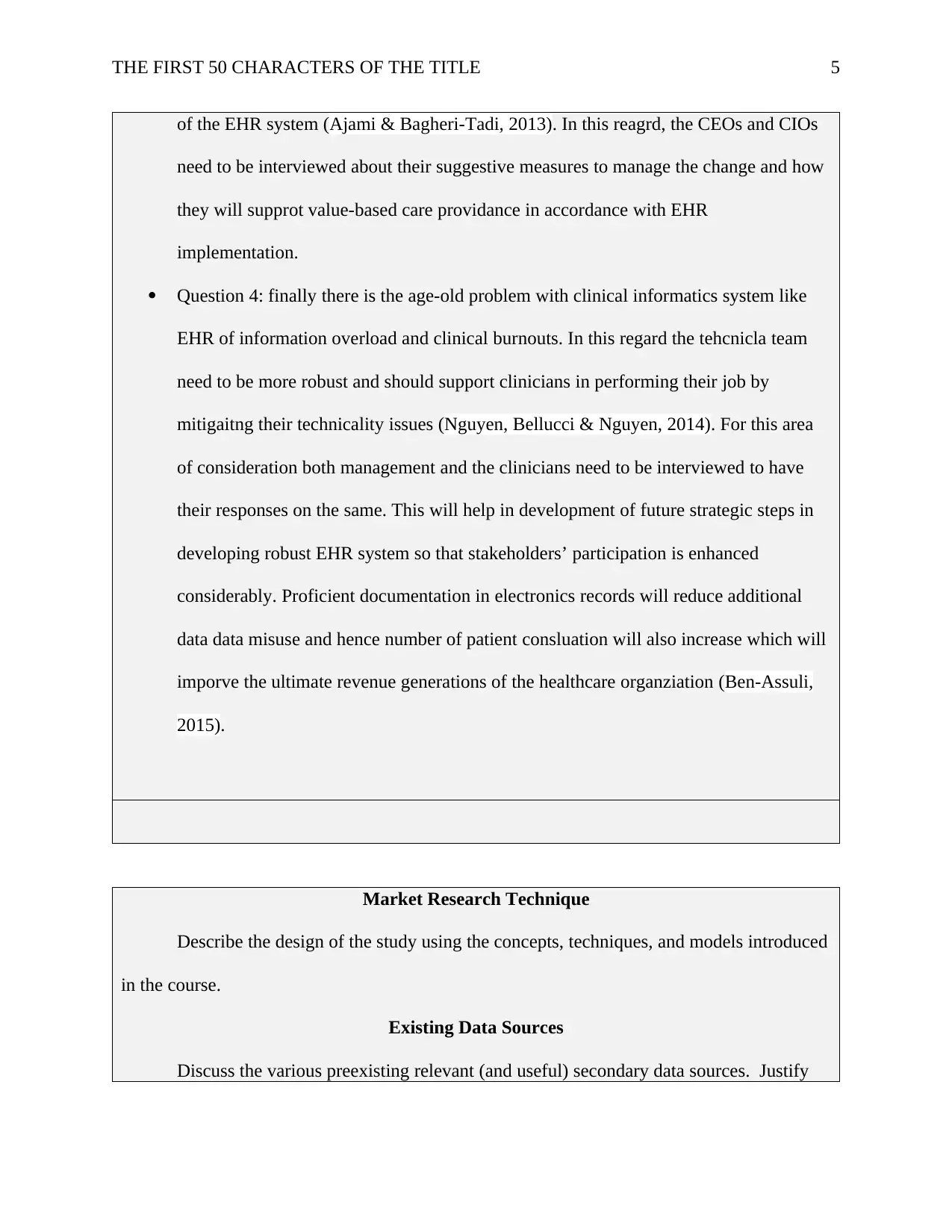
THE FIRST 50 CHARACTERS OF THE TITLE 5
of the EHR system (Ajami & Bagheri-Tadi, 2013). In this reagrd, the CEOs and CIOs
need to be interviewed about their suggestive measures to manage the change and how
they will supprot value-based care providance in accordance with EHR
implementation.
Question 4: finally there is the age-old problem with clinical informatics system like
EHR of information overload and clinical burnouts. In this regard the tehcnicla team
need to be more robust and should support clinicians in performing their job by
mitigaitng their technicality issues (Nguyen, Bellucci & Nguyen, 2014). For this area
of consideration both management and the clinicians need to be interviewed to have
their responses on the same. This will help in development of future strategic steps in
developing robust EHR system so that stakeholders’ participation is enhanced
considerably. Proficient documentation in electronics records will reduce additional
data data misuse and hence number of patient consluation will also increase which will
imporve the ultimate revenue generations of the healthcare organziation (Ben-Assuli,
2015).
Market Research Technique
Describe the design of the study using the concepts, techniques, and models introduced
in the course.
Existing Data Sources
Discuss the various preexisting relevant (and useful) secondary data sources. Justify
of the EHR system (Ajami & Bagheri-Tadi, 2013). In this reagrd, the CEOs and CIOs
need to be interviewed about their suggestive measures to manage the change and how
they will supprot value-based care providance in accordance with EHR
implementation.
Question 4: finally there is the age-old problem with clinical informatics system like
EHR of information overload and clinical burnouts. In this regard the tehcnicla team
need to be more robust and should support clinicians in performing their job by
mitigaitng their technicality issues (Nguyen, Bellucci & Nguyen, 2014). For this area
of consideration both management and the clinicians need to be interviewed to have
their responses on the same. This will help in development of future strategic steps in
developing robust EHR system so that stakeholders’ participation is enhanced
considerably. Proficient documentation in electronics records will reduce additional
data data misuse and hence number of patient consluation will also increase which will
imporve the ultimate revenue generations of the healthcare organziation (Ben-Assuli,
2015).
Market Research Technique
Describe the design of the study using the concepts, techniques, and models introduced
in the course.
Existing Data Sources
Discuss the various preexisting relevant (and useful) secondary data sources. Justify
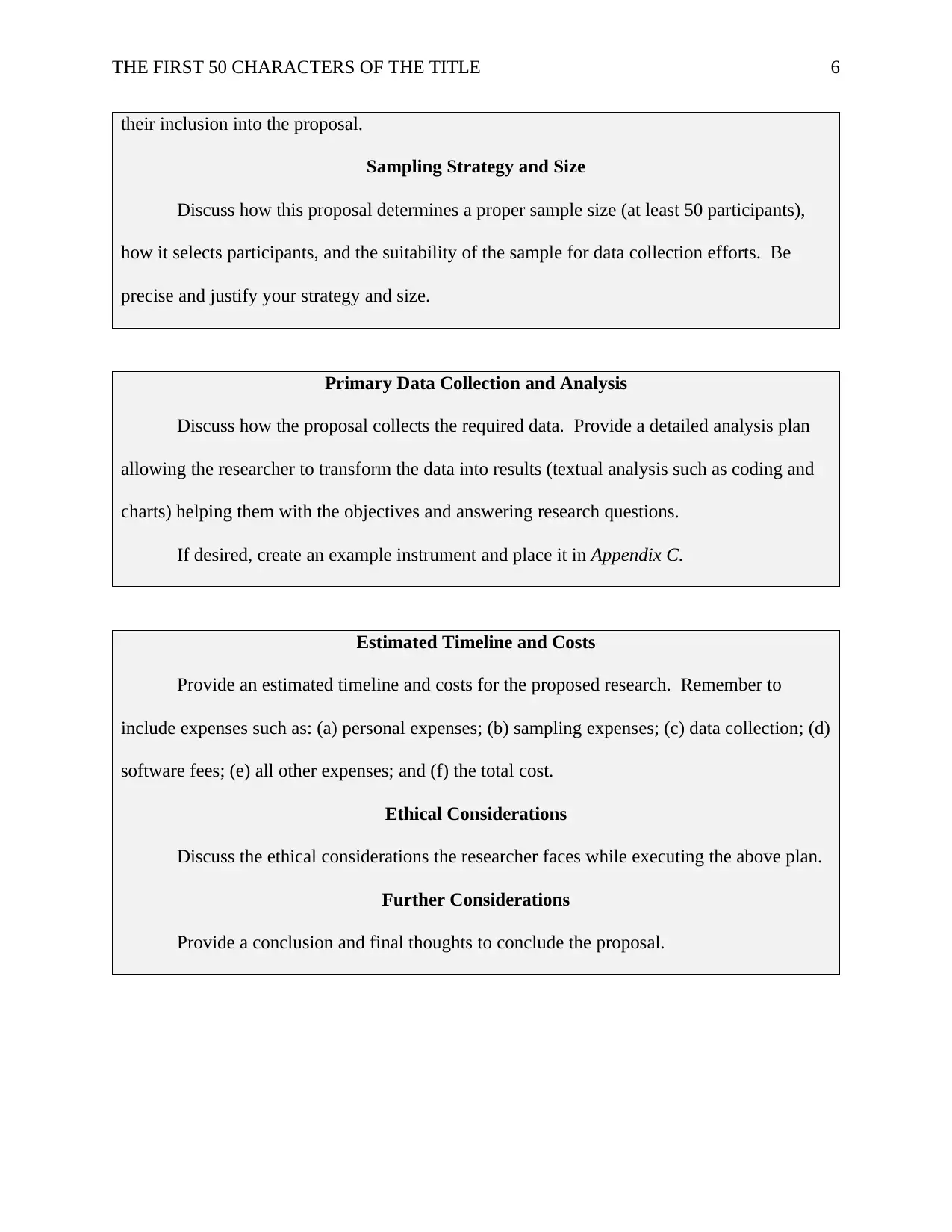
THE FIRST 50 CHARACTERS OF THE TITLE 6
their inclusion into the proposal.
Sampling Strategy and Size
Discuss how this proposal determines a proper sample size (at least 50 participants),
how it selects participants, and the suitability of the sample for data collection efforts. Be
precise and justify your strategy and size.
Primary Data Collection and Analysis
Discuss how the proposal collects the required data. Provide a detailed analysis plan
allowing the researcher to transform the data into results (textual analysis such as coding and
charts) helping them with the objectives and answering research questions.
If desired, create an example instrument and place it in Appendix C.
Estimated Timeline and Costs
Provide an estimated timeline and costs for the proposed research. Remember to
include expenses such as: (a) personal expenses; (b) sampling expenses; (c) data collection; (d)
software fees; (e) all other expenses; and (f) the total cost.
Ethical Considerations
Discuss the ethical considerations the researcher faces while executing the above plan.
Further Considerations
Provide a conclusion and final thoughts to conclude the proposal.
their inclusion into the proposal.
Sampling Strategy and Size
Discuss how this proposal determines a proper sample size (at least 50 participants),
how it selects participants, and the suitability of the sample for data collection efforts. Be
precise and justify your strategy and size.
Primary Data Collection and Analysis
Discuss how the proposal collects the required data. Provide a detailed analysis plan
allowing the researcher to transform the data into results (textual analysis such as coding and
charts) helping them with the objectives and answering research questions.
If desired, create an example instrument and place it in Appendix C.
Estimated Timeline and Costs
Provide an estimated timeline and costs for the proposed research. Remember to
include expenses such as: (a) personal expenses; (b) sampling expenses; (c) data collection; (d)
software fees; (e) all other expenses; and (f) the total cost.
Ethical Considerations
Discuss the ethical considerations the researcher faces while executing the above plan.
Further Considerations
Provide a conclusion and final thoughts to conclude the proposal.
⊘ This is a preview!⊘
Do you want full access?
Subscribe today to unlock all pages.

Trusted by 1+ million students worldwide
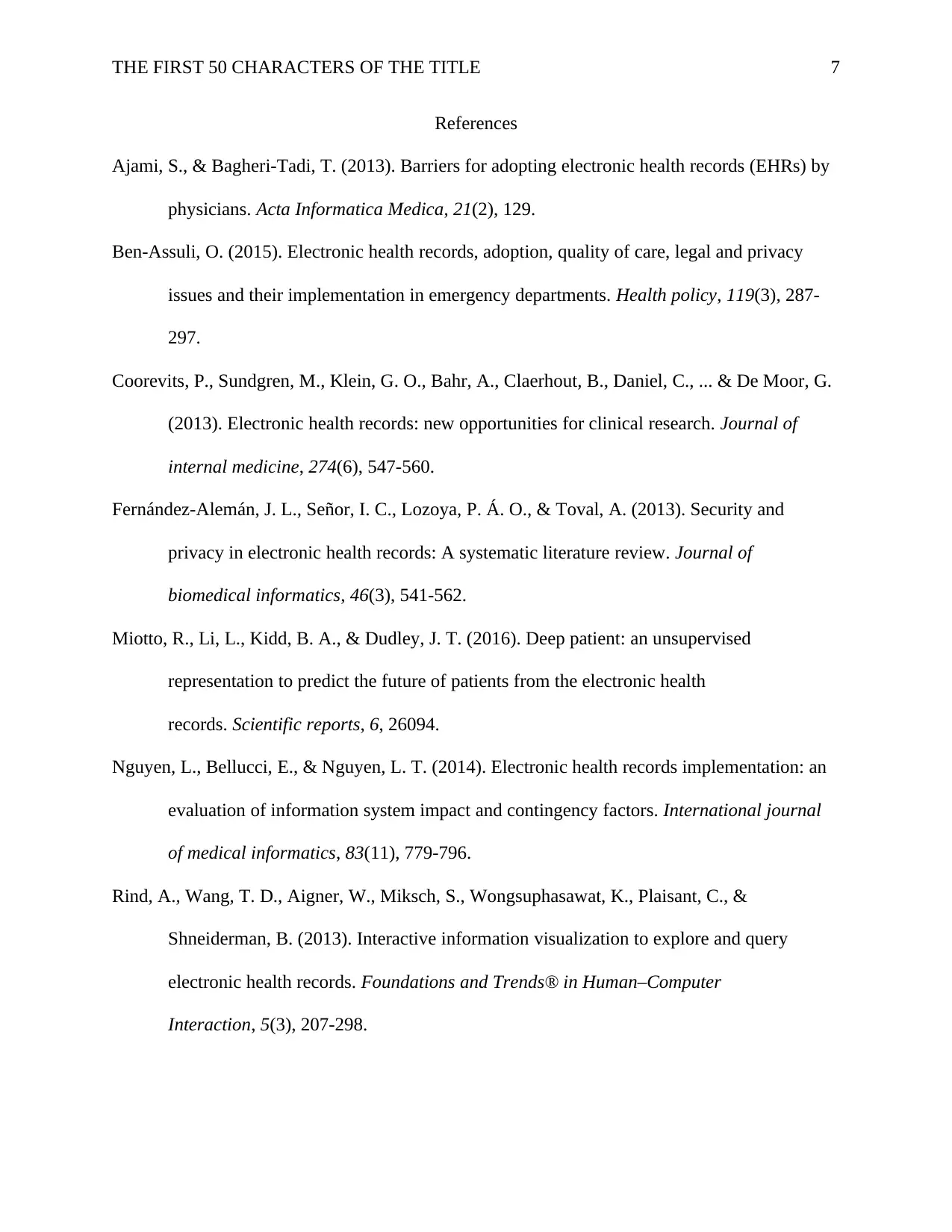
THE FIRST 50 CHARACTERS OF THE TITLE 7
References
Ajami, S., & Bagheri-Tadi, T. (2013). Barriers for adopting electronic health records (EHRs) by
physicians. Acta Informatica Medica, 21(2), 129.
Ben-Assuli, O. (2015). Electronic health records, adoption, quality of care, legal and privacy
issues and their implementation in emergency departments. Health policy, 119(3), 287-
297.
Coorevits, P., Sundgren, M., Klein, G. O., Bahr, A., Claerhout, B., Daniel, C., ... & De Moor, G.
(2013). Electronic health records: new opportunities for clinical research. Journal of
internal medicine, 274(6), 547-560.
Fernández-Alemán, J. L., Señor, I. C., Lozoya, P. Á. O., & Toval, A. (2013). Security and
privacy in electronic health records: A systematic literature review. Journal of
biomedical informatics, 46(3), 541-562.
Miotto, R., Li, L., Kidd, B. A., & Dudley, J. T. (2016). Deep patient: an unsupervised
representation to predict the future of patients from the electronic health
records. Scientific reports, 6, 26094.
Nguyen, L., Bellucci, E., & Nguyen, L. T. (2014). Electronic health records implementation: an
evaluation of information system impact and contingency factors. International journal
of medical informatics, 83(11), 779-796.
Rind, A., Wang, T. D., Aigner, W., Miksch, S., Wongsuphasawat, K., Plaisant, C., &
Shneiderman, B. (2013). Interactive information visualization to explore and query
electronic health records. Foundations and Trends® in Human–Computer
Interaction, 5(3), 207-298.
References
Ajami, S., & Bagheri-Tadi, T. (2013). Barriers for adopting electronic health records (EHRs) by
physicians. Acta Informatica Medica, 21(2), 129.
Ben-Assuli, O. (2015). Electronic health records, adoption, quality of care, legal and privacy
issues and their implementation in emergency departments. Health policy, 119(3), 287-
297.
Coorevits, P., Sundgren, M., Klein, G. O., Bahr, A., Claerhout, B., Daniel, C., ... & De Moor, G.
(2013). Electronic health records: new opportunities for clinical research. Journal of
internal medicine, 274(6), 547-560.
Fernández-Alemán, J. L., Señor, I. C., Lozoya, P. Á. O., & Toval, A. (2013). Security and
privacy in electronic health records: A systematic literature review. Journal of
biomedical informatics, 46(3), 541-562.
Miotto, R., Li, L., Kidd, B. A., & Dudley, J. T. (2016). Deep patient: an unsupervised
representation to predict the future of patients from the electronic health
records. Scientific reports, 6, 26094.
Nguyen, L., Bellucci, E., & Nguyen, L. T. (2014). Electronic health records implementation: an
evaluation of information system impact and contingency factors. International journal
of medical informatics, 83(11), 779-796.
Rind, A., Wang, T. D., Aigner, W., Miksch, S., Wongsuphasawat, K., Plaisant, C., &
Shneiderman, B. (2013). Interactive information visualization to explore and query
electronic health records. Foundations and Trends® in Human–Computer
Interaction, 5(3), 207-298.
Paraphrase This Document
Need a fresh take? Get an instant paraphrase of this document with our AI Paraphraser
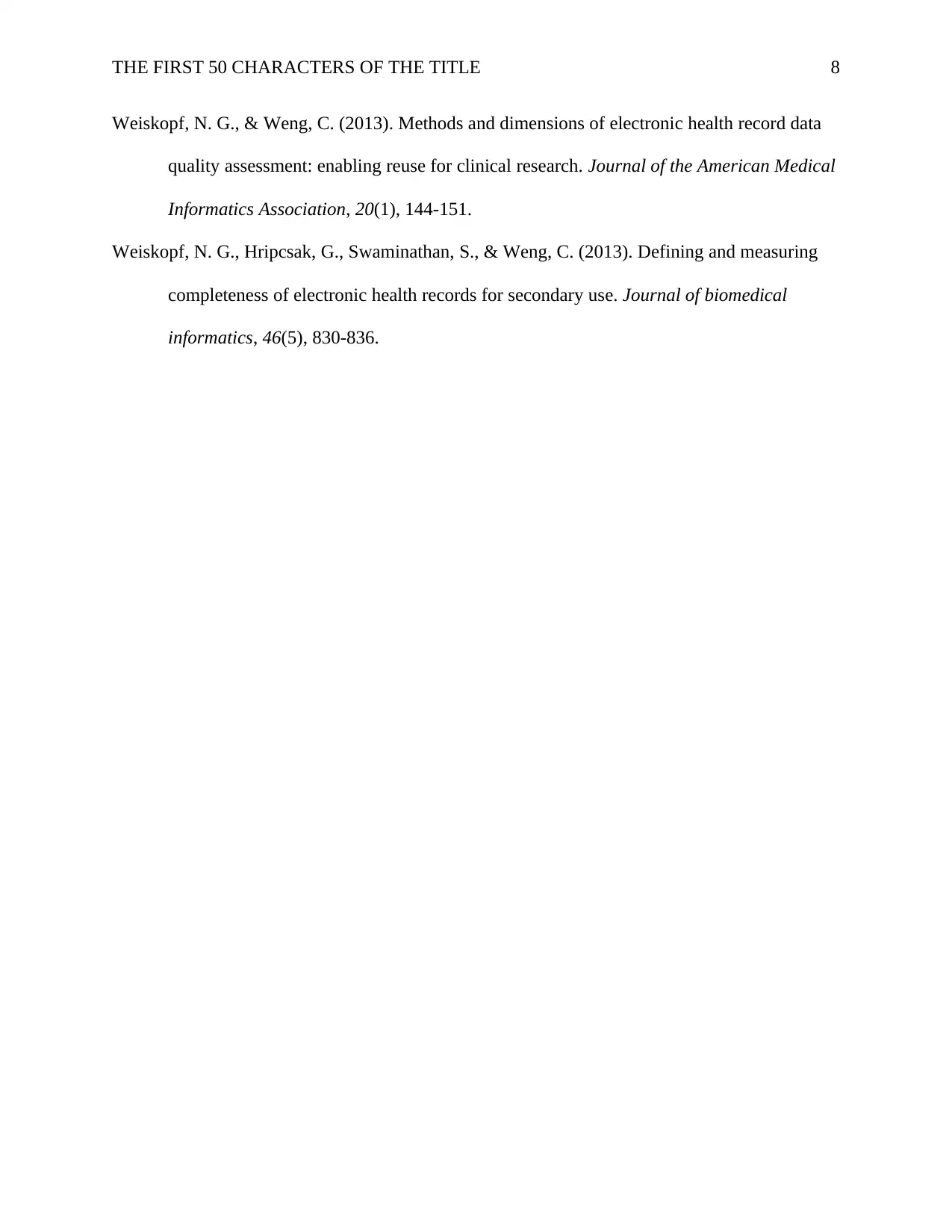
THE FIRST 50 CHARACTERS OF THE TITLE 8
Weiskopf, N. G., & Weng, C. (2013). Methods and dimensions of electronic health record data
quality assessment: enabling reuse for clinical research. Journal of the American Medical
Informatics Association, 20(1), 144-151.
Weiskopf, N. G., Hripcsak, G., Swaminathan, S., & Weng, C. (2013). Defining and measuring
completeness of electronic health records for secondary use. Journal of biomedical
informatics, 46(5), 830-836.
Weiskopf, N. G., & Weng, C. (2013). Methods and dimensions of electronic health record data
quality assessment: enabling reuse for clinical research. Journal of the American Medical
Informatics Association, 20(1), 144-151.
Weiskopf, N. G., Hripcsak, G., Swaminathan, S., & Weng, C. (2013). Defining and measuring
completeness of electronic health records for secondary use. Journal of biomedical
informatics, 46(5), 830-836.

THE FIRST 50 CHARACTERS OF THE TITLE 9
Appendix A: Tables
Appendix A: Tables
⊘ This is a preview!⊘
Do you want full access?
Subscribe today to unlock all pages.

Trusted by 1+ million students worldwide
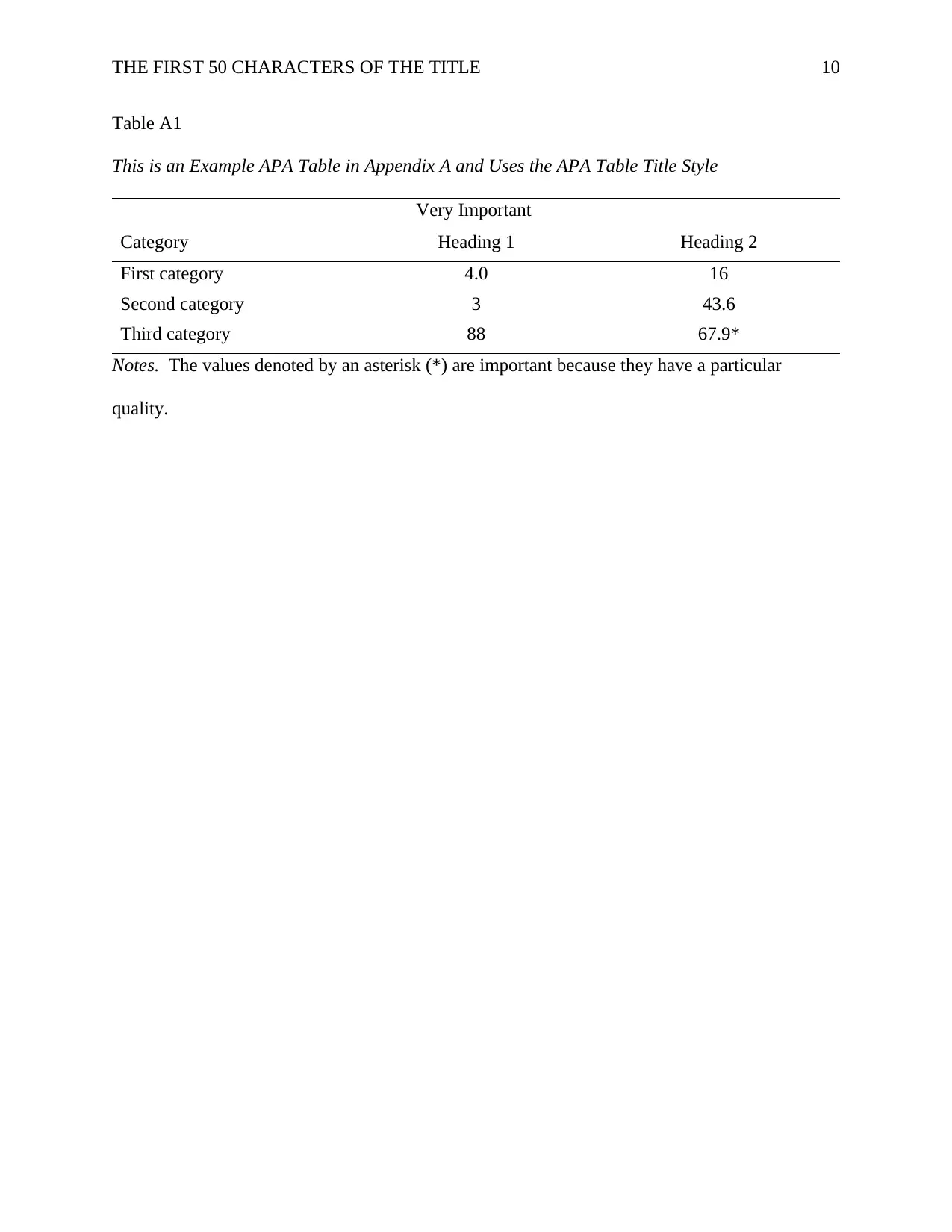
THE FIRST 50 CHARACTERS OF THE TITLE 10
Table A1
This is an Example APA Table in Appendix A and Uses the APA Table Title Style
Category
Very Important
Heading 1 Heading 2
First category 4.0 16
Second category 3 43.6
Third category 88 67.9*
Notes. The values denoted by an asterisk (*) are important because they have a particular
quality.
Table A1
This is an Example APA Table in Appendix A and Uses the APA Table Title Style
Category
Very Important
Heading 1 Heading 2
First category 4.0 16
Second category 3 43.6
Third category 88 67.9*
Notes. The values denoted by an asterisk (*) are important because they have a particular
quality.
Paraphrase This Document
Need a fresh take? Get an instant paraphrase of this document with our AI Paraphraser

THE FIRST 50 CHARACTERS OF THE TITLE 11
Appendix B: Figures
Appendix B: Figures

THE FIRST 50 CHARACTERS OF THE TITLE 12
Figure B1. This is an example APA figure using the APA Caption Style. Neo meets the
Architect while seeking the Source. Notice the caption is not emphasized!
Figure B1. This is an example APA figure using the APA Caption Style. Neo meets the
Architect while seeking the Source. Notice the caption is not emphasized!
⊘ This is a preview!⊘
Do you want full access?
Subscribe today to unlock all pages.

Trusted by 1+ million students worldwide
1 out of 14
Related Documents
Your All-in-One AI-Powered Toolkit for Academic Success.
+13062052269
info@desklib.com
Available 24*7 on WhatsApp / Email
![[object Object]](/_next/static/media/star-bottom.7253800d.svg)
Unlock your academic potential
Copyright © 2020–2025 A2Z Services. All Rights Reserved. Developed and managed by ZUCOL.





